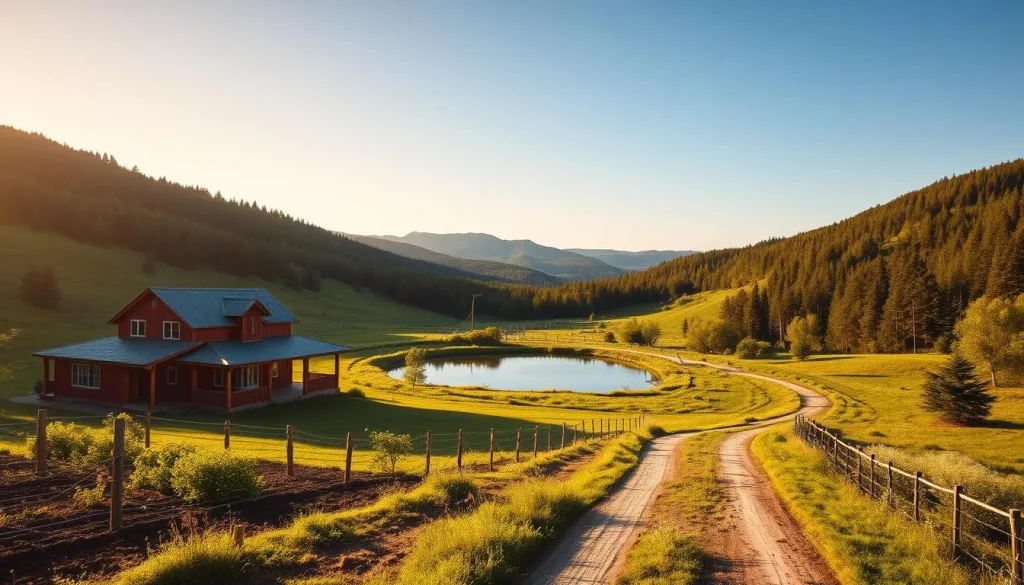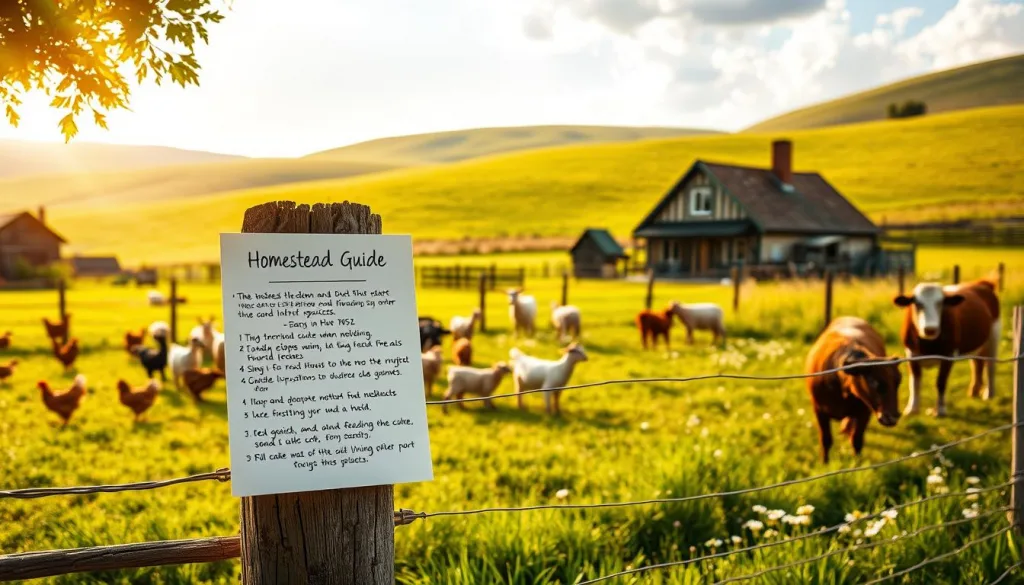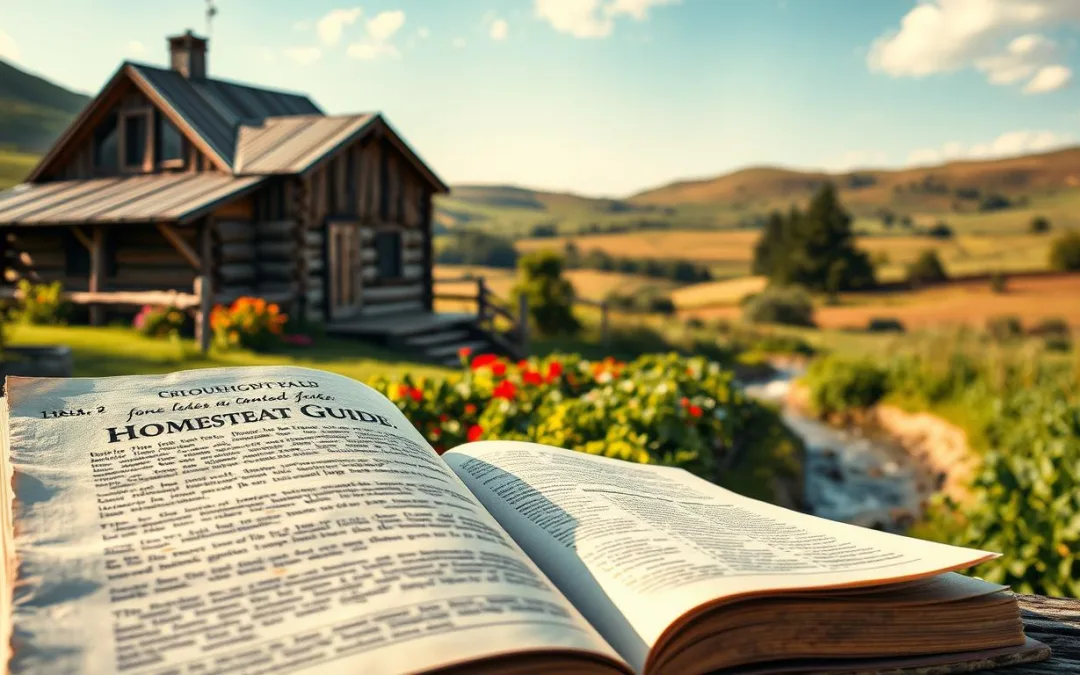Starting a homestead changes how you live, connecting you deeply with nature. It’s not just about owning land. It’s about creating a sustainable ecosystem for your daily needs.
The homesteading guide shows a path to independence. Modern homesteaders enjoy growing their own food and reducing external dependencies. They build resilient living spaces. Tips for starting a homestead stress starting small and growing your skills and resources gradually.
Successful homesteading needs patience and planning. Many new homesteaders feel overwhelmed at first. But, by breaking down the process into steps, anyone can make the transition. Start with one garden bed, spend time learning, and focus on growing your skills slowly.
Key Takeaways
- Homesteading is a journey toward self-sufficiency
- Start small and build skills progressively
- Patience is key in developing a sustainable lifestyle
- Engage with homesteading communities for support
- Focus on learning one skill at a time
Understanding Modern Homesteading and Its Benefits
Homesteading has changed a lot over time. Now, it’s a lifestyle choice for those wanting to live sustainably. Starting a homestead on a budget is easier than before. People are finding new ways to be self-sufficient in different places.
Modern homesteading is more than just farming. It’s a way of life focused on sustainability, self-reliance, and being mindful of our actions.
Defining Modern Homesteading
Research on over 100 homesteaders showed what modern homesteading is all about:
- Being self-sufficient in many areas of life
- Using sustainable practices every day
- Building strong, resilient living systems
- Lessening reliance on big commercial chains
“Homesteading is not about being perfect, but about getting better at being self-sufficient.” – Anonymous Homesteader
Benefits of the Homesteading Lifestyle
Homesteading offers more than just growing food. People often find:
- More control over their food supply
- Lower living costs
- A deeper connection with nature
- Healthier bodies and minds
Diverse Homesteading Approaches
There are many ways to homestead, no matter where you live:
- Urban homesteading in small spaces
- Suburban farming in backyards
- Rural farming on a big scale
- Micro-homesteading in tiny areas
With a little creativity and some effort, anyone can start homesteading. They can turn their home into a place of self-sufficiency.
Essential Planning Before Starting Your Homestead
Starting a self-sufficient homestead needs careful planning and smart thinking. For beginners, it might seem too much. But, breaking it down into smaller steps makes it easier.
Before you start your homesteading journey, think about these important planning points:
- Check your skills and knowledge
- Look at what resources and money you have
- Find out about local laws and zoning
- Make a realistic plan for when to start
Knowing your goals is key when starting a self-sufficient homestead. Many homesteaders suggest 1-2 years of research and learning before starting.
| Homestead Planning Stage | Recommended Duration |
|---|---|
| Research and Learning | 1-2 years |
| Property Search | 6-18 months |
| Initial Implementation | First 5 years |
Start small and grow your homesteading over time. Whether you have a small urban lot or a big rural area, focus on sustainable practices. Make sure they fit your lifestyle and skills.
The key to successful homesteading is patience, continuous learning, and adaptability.
Remember, homesteading is a journey that keeps growing. Your plans will change as you learn more about self-sufficient living.
Tips for Starting a Homestead from Scratch
Starting a homestead needs careful planning and a smart plan. More people want to live off the grid and be self-sufficient. About 75% of those interested in homesteading want a more independent life.
To start a homestead, first, have a clear vision and set achievable goals. Off-grid living advice says start small and grow slowly. Studies show that those who make gradual changes are 30% happier than those who rush.
Crafting Your Homestead Vision
Creating a good homestead vision means knowing your goals and limits. Think about these important points:
- Know why you want to homestead
- Check what resources and space you have
- Plan for long-term sustainability
Setting Realistic Goals and Timelines
Good homesteading planning is key. Here’s how to set goals:
- Set short-term goals for 1 year
- Make medium-term goals for 5 years
- Plan your long-term vision for 10 years
Building Your Homestead Budget
| Expense Category | Estimated Annual Cost |
|---|---|
| Initial Setup | $2,000 – $10,000 |
| Annual Maintenance | $1,500 – $5,000 |
| Potential Income Generation | $1,000 – $5,000 |
Planning your finances is key for a sustainable homestead. About 80% of successful homesteaders use good budgeting. Be ready to cut back on things like vacations and eating out.
Remember, every homestead is unique. Your journey will be personal and shaped by your individual goals and resources.
With patience, smart planning, and realistic goals, you can build a fulfilling and sustainable homestead.
Choosing the Right Location for Your Homestead

Finding the perfect spot is key for homesteaders. The right property can make or break your homesteading dreams. It affects everything from your garden to your livestock.
When looking at homestead sites, keep these points in mind:
- Solar exposure and terrain characteristics
- Soil quality and drainage
- Water availability
- Local climate conditions
- Zoning regulations
Land size is very important for homesteading. Different sizes can handle different activities:
- Under 1 acre: Great for chickens, rabbits, small gardens
- 1-5 acres: Good for chickens, pigs, bigger gardens
- 5+ acres: Best for cows, sheep, goats
“The right location can transform your homesteading dream into a sustainable reality.” – Experienced Homesteader
Places like Oregon, Washington, Tennessee, Vermont, and Maine are great for homesteading. They have friendly communities and lots of land. Even city folks can homestead with vertical gardens and rooftop farms.
Check local laws, think about what you need, and make a detailed plan. The right spot is the start of a great homesteading adventure.
Legal Considerations and Zoning Requirements
Understanding the legal side of homesteading is key. Many rural living tips miss the mark on local laws. These laws can greatly affect your farm dreams.
It’s essential to research local zoning laws before starting your homestead. Each area has its own rules. These rules can change what you can do on your land, like raising animals or growing crops.
Understanding Local Regulations
Local zoning laws are vital for your homestead. Here are some important legal points to consider:
- Property line setback laws determine building distances
- Agricultural land use restrictions
- Livestock ownership regulations
- Potential limitations on farm structures
Required Permits and Licenses
Homesteaders face a complex permitting world. You’ll need:
- Farm exemption permits
- Agricultural business licenses
- EIN (Employer Identification Number)
- Potential LLC formation for liability protection
Right-to-Farm Laws
Right-to-farm laws protect farmers from complaints. They let established farms keep running without trouble from new homes.
“Knowledge of local regulations is your first line of defense in creating a sustainable homestead.” – Rural Farming Expert
Getting ready legally can save you time, money, and headaches. Always talk to local agricultural offices and lawyers. This ensures you follow all local rules.
Basic Infrastructure and Resources Needed
Starting a homestead needs careful planning and smart use of resources. It’s about setting up a self-sufficient home. You’ll need to think about water systems, energy, and more.
Here are the main things to focus on:
- Water collection and storage systems
- Renewable energy sources
- Storage facilities for tools and supplies
- Shelter and workspace structures
- Waste management solutions
Plan your infrastructure to be efficient and green. Managing resources well can save money and boost your homestead’s performance. Today, homesteaders are using new ways to build their homes.
| Infrastructure Component | Estimated Cost | Priority Level |
|---|---|---|
| Water Harvesting System | $500 | High |
| Solar Panel Setup | $1,200 | Medium |
| Storage Barn/Shed | $800 | Medium |
Pro tip: Begin small and grow your setup over time. Many homesteaders suggest watching your land for a year before adding big things. This helps you know your land better and make better choices.
Building a self-sufficient homestead is a journey. Keep learning, be adaptable, and use versatile tools. Stay open to new ideas in building your home.
Starting Your First Homestead Garden
Starting your first homestead garden is a thrilling adventure. As a beginner, it’s important to begin small and learn slowly. Self-sufficient living tips suggest starting with a garden that fits your skill level and space.
Preparing Your Garden Soil
Soil preparation is key for a thriving garden. First, test your soil’s quality and nutrients. Here are some tips for improving your soil:
- Use organic bagged soil mixes
- Add bulk soil with rich organic matter
- Incorporate volcanic rock for mineral content
- Add a handful of worms to each raised bed
Choosing Beginner-Friendly Crops
Choose vegetables your family loves. Experts suggest starting with five easy-to-grow vegetables:
- Tomatoes
- Lettuce
- Zucchini
- Beans
- Herbs
“Start small, learn deeply, and grow confidently” – Homestead Gardening Wisdom
Season Planning and Crop Rotation
Knowing your local growing zones is vital. Use online tools to find your USDA hardiness zone by zip code. Plan your garden with these tips:
| Gardening Aspect | Recommendation |
|---|---|
| Garden Size | 2 raised beds (15 inches deep) |
| Transplanting | 2 weeks after last spring frost |
| Fertilizing | Once per year when switching crops |
By following these tips, you’ll create a productive garden. It will give you fresh produce and teach you valuable skills. Remember, gardening gets better with time and patience.
Livestock Options for Beginners

Choosing the right livestock is key for new homesteaders. It’s wise to start small and learn as you go. Successful homesteaders know the value of starting with a few animals.
Begin with animals that fit your resources and experience. Here are some good choices for beginners:
- Chickens: Great for newbies, giving eggs and meat
- Rabbits: Small, breed fast, and are a good protein source
- Goats: Useful for milk, meat, and managing land
- Ducks: Tougher than chickens, with great foraging skills
“Start small and grow your flock or herd as you gain confidence and knowledge.” – Experienced Homesteader
Important things to think about when managing livestock include:
- Local zoning laws
- Space you have
- Costs to start
- What you need to care for them
Experts say start with 6-8 chickens or 2-3 goats. This lets you learn without feeling overwhelmed. Joining local farming groups can give you great tips.
Creating a Sustainable Water and Power System
Building a reliable water and power system is key for off-grid living. Homesteaders need to plan their water and energy solutions well. Sustainable homesteading tips start with knowing your property’s resources and possibilities.
Water Collection and Storage Strategies
Managing water is vital for off-grid living. Americans use 80 to 100 gallons of water daily. So, collecting and storing water efficiently is essential.
Rainwater catchment systems are a great solution. They range from simple rain barrels to big cistern setups:
- Rain barrels hold 55 gallons
- IBC totes store 275 to 330 gallons
- Elevated cisterns create passive water pressure
Alternative Energy Solutions
Renewable energy is changing homestead power systems. Homesteads often use wind or solar power more than traditional homes. Some companies even pay for extra energy, which can be a good income source.
Off-Grid Power Considerations
For sustainable homesteading, energy planning is important. Key factors include:
- Figuring out total energy needs
- Designing the right renewable systems
- Having backup power sources
By using smart water collection and renewable energy, homesteaders can build strong, self-sufficient homes. These homes rely less on outside help.
Homestead Food Preservation Methods
Starting your journey to self-sufficiency begins with learning how to preserve food. A simple dehydrator, costing around $35, opens up many ways to store fruits, veggies, and herbs. Canning and preserving are key for keeping your garden’s bounty all year long.
Each food type has its own preservation method. Freezing is great for strawberries and peas. Canning is best for tomatoes and cherries. Dehydrating lets you store fruits and veggies for 6-12 months, and herbs for up to 3 years.
Vacuum sealing can keep fresh berries fresh for weeks. Root cellaring is another great way to keep veggies and fruits fresh. It’s perfect for winter months. Flash freezing also helps keep your food’s color, texture, and taste.
Having a preservation calendar is key to avoiding waste. It helps you use your stored food wisely. Whether it’s for soups, stews, or gifts, knowing these methods makes your homestead a year-round food source. With the right planning and skills, you can create a sustainable food preservation plan that supports your self-sufficient lifestyle.
FAQ
What exactly is modern homesteading?
How much land do I need to start a homestead?
What are the initial costs of starting a homestead?
What skills are most important for successful homesteading?
How do I handle zoning and legal restrictions?
Can I homestead if I work a full-time job?
What are the best starter livestock for beginners?
How can I generate alternative energy on my homestead?
What food preservation methods should I learn first?
How do I develop a water management system?
Source Links
- 7 Ways to Start a Homestead (Without Being Overwhelmed) – https://www.tenthacrefarm.com/start-a-homestead/
- Beginning homesteading: A guide for beginners – The Domestic Geek Blog – https://www.thedomesticgeekblog.com/beginning-homesteading-guide-beginners/
- What Is Modern Homesteading and How To Get Started – The Small Town Homestead – https://redemptionpermaculture.com/what-is-modern-homesteading-and-how-to-get-started/
- Homesteading: A Beginner’s Guide to Sustainable Living – https://savingwaldensworld.org/homesteading-a-beginners-guide/
- Start Homesteading for Beginners: 10 Ways to Prep for Your Homestead – https://zerowastehomestead.com/how-to-start-homesteading-for-beginners-10-ways-to-prepare-for-your-future-homestead-before-buying/
- The Ultimate Beginners Guide to Homesteading (5 Steps!) – https://thehomesteadingrd.com/homesteading-for-beginners/
- How to Make a Homestead Plan – https://www.oakhillhomestead.com/2022/12/make-a-homestead-plan.html
- How To Start A Homestead: A Beginners Guide – https://www.lifeatcobblehillfarm.com/2023/04/how-to-start-homestead-beginners-guide.html
- How To Start a Homestead: Step By Step Beginners Guide | GroCycle – https://grocycle.com/how-to-start-a-homestead/
- How to Start a Homestead From Scratch • The Prairie Homestead – https://www.theprairiehomestead.com/2021/10/how-to-start-a-homestead-from-scratch.html
- How to Plan a Homestead | Wild + Whole – https://www.themeateater.com/wild-and-whole/homesteading/how-to-plan-a-homestead
- How to Choose Where You Should Start a Homestead – Our Frugal Florida Homestead – https://ourfrugalfloridahomestead.com/how-to-choose-where-you-should-start-a-homestead/
- What To Look For When Buying Land For Homesteading – Mother Earth News – https://www.motherearthnews.com/homesteading-and-livestock/selecting-a-homestead-site-zmaz71jfzsto/
- The Complete Legal Guide to Homesteading – fairwaystables.com – https://fairwaystables.com/homesteading/the-complete-legal-guide-to-homesteading/
- Being Informed: Legal Issues on the Homestead – https://whollyholyliving.com/2017/10/10/being-informed-legality-on-the-homestead/
- Starting A Homestead From Scratch (Our Story) – https://thefrugalchicken.com/starting-a-homestead-from-scratch-our-story/
- Homestead Infrastructure – Steel Raven Farms – https://steelravenfarms.com/blog/homestead-infrastructure/
- Starting a New Homestead: What You Need to Know – Reformation Acres – https://www.reformationacres.com/starting-new-homestead/
- How to Homestead – A Guide for Beginners – https://commonsensehome.com/how-to-homestead/
- Homestead Garden: A Beginner’s Guide – https://thriftyhomesteader.com/a-beginners-guide-to-gardening/
- How To Start A Garden: 101 – https://homesteadandchill.com/how-to-start-a-garden-101/?srsltid=AfmBOoqmouINW4isDbRIn04uYZNsd4NQMPGjBhrV8auA_jmL_Y2C0c7z
- How to Get Started Homesteading – https://homesteadingfamily.com/how-to-get-started-homesteading/
- What Livestock Should I Raise and How Many? – Homesteady – https://www.thisishomesteady.com/what-livestock-should-i-raise/
- How to Raise a Year’s Worth of Meat – https://homesteadingfamily.com/how-to-raise-a-years-worth-of-meat/
- Raising Meat on a Small Homestead • The Prairie Homestead – https://www.theprairiehomestead.com/2015/11/raising-meat-small-homestead.html
- Getting Started With Off-Grid Water System For A More Self-Reliant Homestead • Insteading – https://insteading.com/blog/off-grid-water-system/
- The Complete Guide to Off Grid Water Systems for Homesteaders – Rustic Skills Homesteading – https://homesteading.rusticskills.com/off-grid-water-systems/how-to-build-an-off-grid-water-system/
- Food Preservation: A Year at a Glance – https://homesteadingfamily.com/food-preservation-a-year-at-a-glance/
- Food Preservation Methods You Need To Know – https://gubbahomestead.com/podcast/food-preservation-methods-you-need-to-know/
- Home Preserving: Food Preservation Techniques for Beginning Homesteaders – https://zerowastehomestead.com/preserving-vegetables-and-fruit-7-food-preservation-techniques-for-beginning-homesteaders/


